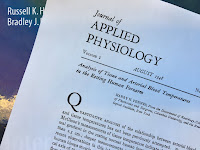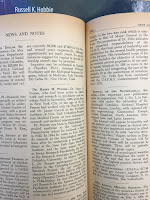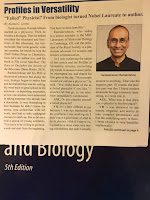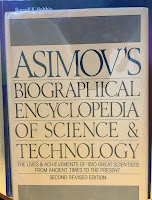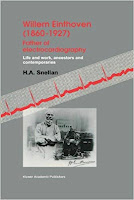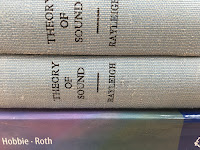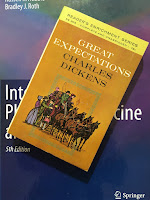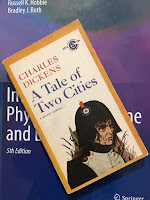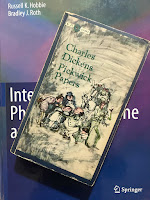 |
| Asimov's Biographical Encyclopedia of Science and Technology |
CRICK, Francis Harry Compton
English biochemist
Born: Northampton, June 8, 1916
Crick was educated at University College in London and went on to obtain his Ph.D. at Cambridge University in 1953. He was a physicist to begin with and worked in the field during World War II, when he was involved in radar research and in magnetic mine development…
At the time, under the leadership of [Max] Perutz, a veritable galaxy of physics-minded scientists was turning to biochemistry at Cambridge and their refined probings established the science of molecular biology, as fusion of biology, chemistry, and physics…
Crick was one of the physicists who turned to biochemistry or, rather, to molecular biology, and with him was a young American, James Dewey Watson…
 |
| The Eighth Day of Creation, by Horace Freeland Judson. |
Crick is to an unusual extent self-educated in biology. He went to a minor English public school, Mill Hill, in northern London; his interest in science was already so single-minded that his family thought him odd. At University College, London, he read physics and had nearly finished his doctorate when the war broke out and a German bomb destroyed his laboratory and gear. When Crick left the Admiralty and physics in 1947, he set out to master the literature of biology, reading with an appetite that has slackened, if at all, only in the last few years [Judson published The Eighth Day of Creation in 1979]. His peers concede without question his astonishing reach. Perutz, whose knowledge is encyclopedic in scope and order: “Francis of course reads more widely than the rest of us.” Jacques Monod, the science’s other great theorist: “No one man discovered or created molecular biology. But one man dominates intellectually the whole field, because he knows the most and understands the most. Francis Crick.”This idea that you have to read the literature resonates with me. I spent the first months of graduate school at Vanderbilt reading research articles about how nerves worked. I took no classes in neurobiology. I didn’t have a biological mentor (my PhD advisor, John Wikswo, was a physicist). I just read. That's the way many physicists learn biology.
Judson humorously tells of Crick's introduction to Perutz's laboratory:
"The first thing Francis did was to read everything we had done," Perutz said. "Then he started criticizing."Why did Crick change to biology? Judson explains
“An important reason Crick changed to biology, he said to me, was that he is an atheist, and was impatient to throw light into the remaining shadowy sanctuaries of vitalistic illusions. ‘I had read [Erwin] Schrodinger’s little book [What is Life?], too [According to Judson, "everyone read Schrodinger."]. Essentially, if you read that book critically, the main import is very peculiar; for one thing, it’s a book written by a physicist who doesn’t know any chemistry! But the impact—there’s no doubt that Schrodinger wrote it in a compelling style, not like the junk that most people write, and it was imaginative. It suggested that biological problems could be thought about, in physical terms—and thus gave the impression that exciting things in this field were not far off. My own motives I never had any doubt about; I was very clear in my mind. Because when I decided to leave the Admiralty, when I was about thirty, then on the grounds that I knew so little anyway I might just as well go into anything I liked, I looked around for fields which would illuminate this particular point of view, against vitalism. And the two fields I chose were what we would now call molecular biology, though the term wasn’t common then, certainly I didn’t know it—but I would have said the borderline between the living and nonliving. That was the phrase I had in my mind, on the one hand. And on the other, the higher nervous system and this problem of consciousness...”
 |
| What Mad Pursuit: A Personal View of Scientific Discovery, by Francis Crick. |
"By the time most scientists have reached age thirty they are trapped by their own expertise. They have invested so much effort in one particular field that it is often extremely difficult, at that time in their careers, to make a radical change. I, on the other hand, knew nothing, except for a basic training in somewhat old-fashioned physics and mathematics and an ability to turn my hand to new things. I was sure in my mind that I wanted to do fundamental research rather than going into applied research...I'm not sure Crick's reflections can be generalized. To me, they imply that the choice of a research topic can be haphazard and personal.
Since I essentially knew nothing, I had an almost completely free choice...Working in the Admiralty, I had several friends among the naval officers. They were interested in science but knew even less about it than I did. One day I noticed that I was telling them, with some enthusiasm, about recent advances in antibiotics—penicillin and such. Only that evening did it occur to me that I myself really knew almost nothing about these topics...It came to me that I was not really telling them about science. I was gossiping about it.
This insight was a revelation to me. I had discovered the gossip test—what you are really interested in is what you gossip about. Without hesitation, I applied it to my recent conversations. Quickly I narrowed down my interests to two main areas: the borderline between the living and nonliving, and the workings of the brain..."
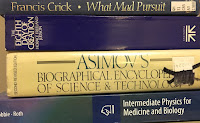 |
| Four good books. |
"Physicists are all too apt to look for the wrong sorts of generalizations, to concoct theoretical models that are too neat, too powerful, and too clean. Not surprisingly, these seldom fit well with the data. To produce a really good biological theory one must try to see through the clutter produced by evolution to the basic mechanisms lying beneath them, realizing that they are likely to be overlaid by other, secondary mechanisms. What seems to physicists to be a hopelessly complicated process may have been what nature found simplest, because nature could only build on what was already there...Crick is a case study into how and why a physicist switches to studying biology. Readers of Intermediate Physics for Medicine and Biology who are contemplating such a switch may benefit from his story.
The job of theorists, especially in biology, is to suggest new experiments. A good theory makes not only predictions, but surprising predictions that then turn out to be true. (If its predictions appear obvious to experimentalists, why would they need a theorist?) ... If this book helps anyone to produce good biological theories, it will have performed one of its main functions."
Want to learn more? Listen to Crick himself discuss how he became interested in science.
Listen to Francis Crick talking about how he became interested in science.
